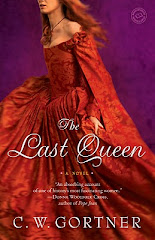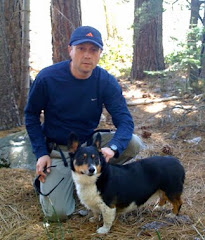 Jeri Westerson is one of my favorite new mystery writers, forging a place for herself in the medieval "noir" genre with her exciting Crispin Guest series. In her debut, VEIL OF LIES, Jeri delivered a compelling, gritty portrait of the tangled alleyways and dangers of life in 14th century London and introduced us to Crispin, a disgraced knight struggling to make ends meet as a detective-for-hire. The second in the series, SERPENT IN THE THORNS, promises to be equally engrossing, as a simple-minded tavern girl stirs up trouble for Crispin when a body is found in her room.
Jeri Westerson is one of my favorite new mystery writers, forging a place for herself in the medieval "noir" genre with her exciting Crispin Guest series. In her debut, VEIL OF LIES, Jeri delivered a compelling, gritty portrait of the tangled alleyways and dangers of life in 14th century London and introduced us to Crispin, a disgraced knight struggling to make ends meet as a detective-for-hire. The second in the series, SERPENT IN THE THORNS, promises to be equally engrossing, as a simple-minded tavern girl stirs up trouble for Crispin when a body is found in her room. As part of her blog tour, Jeri has kindly offered this guest post. Please join me in giving her a warm welcome!
As part of her blog tour, Jeri has kindly offered this guest post. Please join me in giving her a warm welcome!Swan Upping by Jeri Westerson
No, it’s not playing poker with a swan nor is it some sort of illegal and unsavory practice with water fowl. In fact, it has everything to do with legality, monarchs, and, strangely enough, swans.
Swans were an important part of medieval life in London. They were, of course, the most prominent of water fowl on the Thames. And for the most part, they are mute. Much better to have around than geese, which are not by any means mute. Swans were also an important figure in heraldry, on the shields and arms of noble houses. A swan is a noble-looking animal, sleek, elegant, majestic. But they are a bit dim. After all, once the Swan Uppers get the upper hand, as it were, why don’t the silly sods fly away?
So what is Swan Upping? Or a Swan Upper, for that matter? Swan Upping is the twelfth century tradition of counting all the swans on the river Thames. Swan was quite the delicacy for the rich in the Middle Ages, and the head honcho of England naturally wanted to have the majority of the swanage. You had to know how many there were and so, once a year, in the third week of July, the Swan Uppers row up the Thames (see, I knew you thought "Swan Uppers" was swan cocaine), grab swans, and count them. All those unmarked by others, were sent to the king’s table.
In the fifteenth century, swan ownership was shared by the Vitner’s Company and the Dyers Company, two liveried guilds of London. When they went about in their boats, they surround the swans and marked them by nicking their beaks. (Nowadays, the uppers ring the feet of the swans so they know which guild they belong to).
As I said, swan was quite the delicacy. Here’s a lovely roasted swan recipe from Curye on Inglish: English Culinary Manuscripts of the Fourteenth-Century (Including the Forme of Cury) by Constance B. Hieatt and Sharon Butler:
No, it’s not playing poker with a swan nor is it some sort of illegal and unsavory practice with water fowl. In fact, it has everything to do with legality, monarchs, and, strangely enough, swans.
Swans were an important part of medieval life in London. They were, of course, the most prominent of water fowl on the Thames. And for the most part, they are mute. Much better to have around than geese, which are not by any means mute. Swans were also an important figure in heraldry, on the shields and arms of noble houses. A swan is a noble-looking animal, sleek, elegant, majestic. But they are a bit dim. After all, once the Swan Uppers get the upper hand, as it were, why don’t the silly sods fly away?
So what is Swan Upping? Or a Swan Upper, for that matter? Swan Upping is the twelfth century tradition of counting all the swans on the river Thames. Swan was quite the delicacy for the rich in the Middle Ages, and the head honcho of England naturally wanted to have the majority of the swanage. You had to know how many there were and so, once a year, in the third week of July, the Swan Uppers row up the Thames (see, I knew you thought "Swan Uppers" was swan cocaine), grab swans, and count them. All those unmarked by others, were sent to the king’s table.
In the fifteenth century, swan ownership was shared by the Vitner’s Company and the Dyers Company, two liveried guilds of London. When they went about in their boats, they surround the swans and marked them by nicking their beaks. (Nowadays, the uppers ring the feet of the swans so they know which guild they belong to).
As I said, swan was quite the delicacy. Here’s a lovely roasted swan recipe from Curye on Inglish: English Culinary Manuscripts of the Fourteenth-Century (Including the Forme of Cury) by Constance B. Hieatt and Sharon Butler:
For to prepare a swan. Take & undo him & wash him, & do on a spit & lard him fair & roast him well; & dismember him on the best manner & make a fair carving, & the sauce thereto shall be made in this manner, & it is called: Chaudon. Take the issue of the swan & wash it well, & scour the guts well with salt, & boil the issue all together til it be enough, & then take it up and wash it well & hew it small, & take bread & powder of ginger & of galingale & grind together & temper it with the broth, & color it with the blood. And when it is boiled & ground & strained, salt it, & boil it well together in a small pot & season it with a little vinegar.
Doesn’t that sound tasty?
If you’d like to watch a little swan upping (and who wouldn’t), watch this YouTube offering: http://www.youtube.com/watch?v=KUFB_mH0to0 )
Thank you, Jeri! To find out more about Jeri and her work, please visit her at her website.












